Automatic Pill Dispenser Market Size and Share
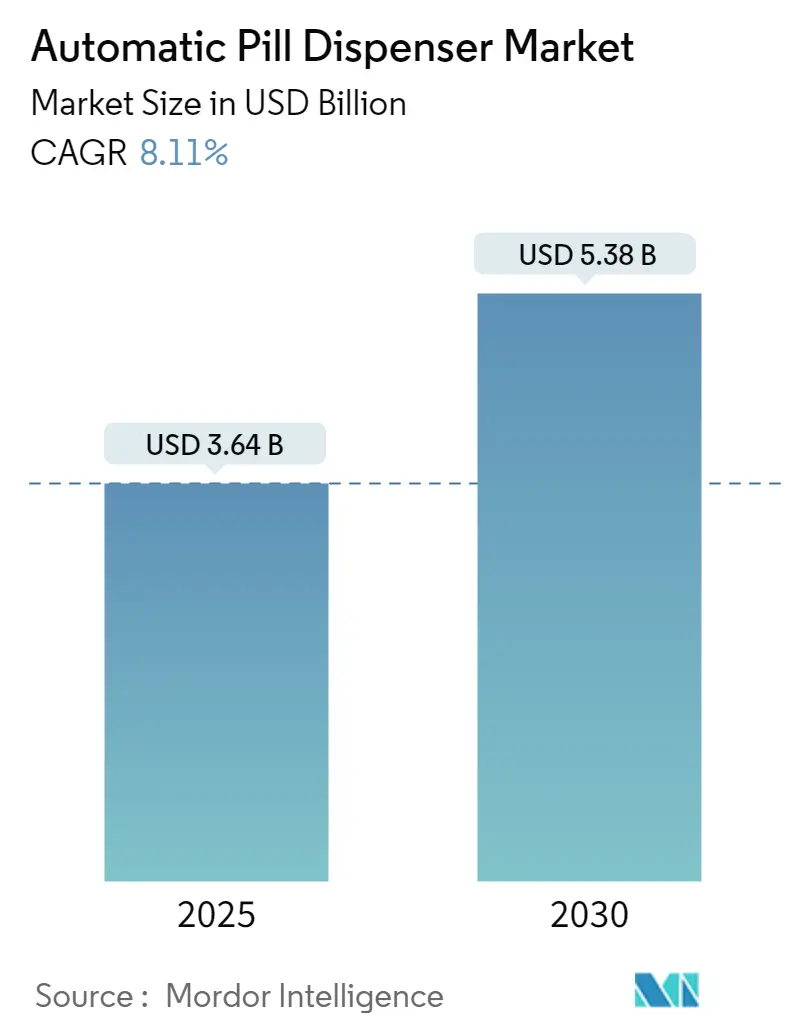
Automatic Pill Dispenser Market Analysis by Mordor Intelligence
The automatic pill dispenser market size is estimated at USD 3.64 billion in 2025, and is expected to reach USD 5.38 billion by 2030, at a CAGR of 8.11% during the forecast period (2025-2030). Rising chronic-disease prevalence, the economic toll of medication non-adherence, and rapid connectivity upgrades are pushing hospitals and households toward automated dispensing solutions. Healthcare providers view connected devices as preventive tools that avert costly emergency visits; payers have begun to reimburse them under value-based care models. Meanwhile, the convergence of IoT, artificial intelligence, and closed-loop verification is moving medication management from reactive refills to predictive oversight. Competitive intensity is deepening as incumbents defend hospital accounts while data-centric start-ups target the growing home-care user base and regional regulators tighten cyber-security requirements.
Key Report Takeaways
- By product type, centralized systems held 59.54% of automatic pill dispenser market share in 2024; decentralized units are forecast to expand at a 9.81% CAGR through 2030.
- By technology, programmable electronic units led revenue with a 38.54% share in 2024, whereas IoT-connected dispensers are poised for a 12.61% CAGR to 2030.
- By indication, chronic disease management accounted for 57.26% of the automatic pill dispenser market size in 2024; neuro-degenerative disorders & dementia represent the fastest-growing use case at a 10.29% CAGR.
- By end-user, hospitals commanded 46.32% of 2024 revenue, while the home-healthcare segment is on track for an 11.78% CAGR during 2025-2030.
- By geography, North America led with 40.84% revenue in 2024; Asia-Pacific is projected to post an 11.37% CAGR through 2030.
Global Automatic Pill Dispenser Market Trends and Insights
Drivers Impact Analysis
| Driver | (~) % Impact on CAGR Forecast | Geographic Relevance | Impact Timeline |
|---|---|---|---|
| Increasing elderly population along with growing burden of diseases | +2.1% | Global, with highest impact in Japan, Western Europe, North America | Long term (≥ 4 years) |
| Escalating cost of medication non-adherence to health systems | +1.8% | North America & Western Europe, emerging impact in APAC | Medium term (2-4 years) |
| Hospital demand for workflow efficiency & medication error reduction | +1.5% | Global, with early adoption in North America | Medium term (2-4 years) |
| Expansion of home healthcare & remote patient management models | +2.3% | North America, Western Europe, with growing relevance in urban APAC | Long term (≥ 4 years) |
| Technological advancements in healthcare | +1.2% | Global, with innovation hubs in North America, Western Europe, Japan | Short term (≤ 2 yrs) |
| Regulatory support and insurance reimbursement | +0.9% | North America, with gradual adoption in EU and select APAC markets | Medium term (2-4 years) |
| Source: Mordor Intelligence | |||
Increasing Elderly Population Drives Specialized Dispenser Development
Global aging is recasting the automatic pill dispenser market as vendors redesign interfaces for users with memory loss and reduced dexterity. In Japan, citizens aged 65+ already exceed 29%, forcing health-tech firms to prioritize large-font displays, voice prompts, and simplified loading cassettes. Locked compartments and multi-alarm cues in devices such as TabTime Medelert help mitigate dose confusion among individuals with dementia. Hospitals incorporate these geriatric-friendly units into discharge plans, while community pharmacies bundle them with counseling services to sustain adherence at home. Collectively, these design shifts are carving a sizable subsegment focused on cognitive-supportive dispensing.
Escalating Cost of Medication Non-Adherence Drives Investment
Payers lose billions to preventable admissions when patients miss doses; interventions that automate pill timing now qualify as cost-saving rather than elective. The Centers for Disease Control and Prevention lists automated pharmacy tools among proven cardiovascular-disease mitigation methods.[1]Source: Centers for Disease Control and Prevention, “Pharmacy-Based Interventions to Improve Medication Adherence,” cdc.gov Hospitals calculate three-year payback periods from fewer readmissions, and insurers are piloting device reimbursement for high-risk chronic cohorts. This economic calculus has prompted integrated-delivery networks to embed dispensing analytics inside population-health dashboards, linking refill reminders to predicted hospitalization risk.
Hospital Demand for Workflow Efficiency Transforms Dispensing Systems
Centralized robots track inventory in real time and sync with electronic health records, shrinking medication preparation time by 30% and cutting errors by 31% in multicenter studies. Pinderfields Hospital’s 2024 rollout of an automated cabinet underlines how acute-care facilities leverage closed-loop tracing to redeploy pharmacists toward clinical counseling. Decentralized ward cabinets complement these hubs, letting nurses retrieve ordered doses without entering the main pharmacy. Collectively, such workflow redesign frees bedside staff for patient-facing tasks and enhances traceability.
Expansion of Home Healthcare & Remote Patient Management Models
Hospital-at-home programs move complex patients to residential settings, fueling demand for consumer devices that still enable professional oversight. Connected dispensers pair audible alerts with caregiver dashboards; the Hero platform exemplifies this bridge by notifying relatives of missed doses while transmitting adherence logs to physicians. Telehealth providers integrate these data streams into virtual rounds, creating a seamless continuum from prescription to ingestion. Market entrants are bundling subscription refills, 24-hour support, and app-based education, reshaping revenue models beyond hardware sales.
Restraints Impact Analysis
| Restraint | (~) % Impact on CAGR Forecast | Geographic Relevance | Impact Timeline |
|---|---|---|---|
| High capital and upkeep costs deter small facilities | -1.7% | Emerging markets, small U.S. hospitals | Short term (≤ 2 years) |
| Data-security concerns complicate connected-device approvals | -1.2% | US, EU | Medium term (2-4 years) |
| Integration complexity | ~-0.9% | Global, with higher impact in regions with fragmented healthcare IT infrastructure | Short term (≤ 2 yrs) |
| Shortage of trained personnel | ~-0.7% | Emerging markets in APAC, MEA, and parts of Latin America | Medium term (~ 3-4 yrs) |
| Source: Mordor Intelligence | |||
High Capital and Maintenance Costs Limit Institutional Adoption
A full-scale central pharmacy robot can exceed USD 100,000 in up-front outlay, exclusive of service contracts and software licenses. Smaller community hospitals and independent pharmacies often lack reimbursement mechanisms to offset this investment, perpetuating manual processes and widening the safety divide between resource-rich and resource-constrained settings. Financing models such as equipment leasing and outcome-based service fees are emerging but remain scarce outside North America.
Data Security Concerns Complicate Connected Dispenser Adoption
As IoT features proliferate, regulators apply both medical-device and data-privacy statutes. HIPAA in the U.S. and GDPR in the EU require encrypted transmissions and auditable access logs. Partnerships like Quantum eMotion’s cryptographic integration with Becton Dickinson illustrate industry movement toward quantum-safe security layers.[2]Source: Quantum eMotion Corp., “Quantum eMotion Partners with Becton Dickinson,” stocktitan.net Device makers must now allocate R&D budgets to cybersecurity, lengthening approval cycles and raising development costs.
Segment Analysis
By Product Type: Hospital-Centric Robots Versus Emerging Ward Cabinets
Centralized systems generated 59.54% of the automatic pill dispenser market size in 2024, anchoring pharmacy operations with robotic arms, carousels, and bar-code readers that manage thousands of SKUs with single-dose precision. Their dominance stems from proven error-reduction metrics and inventory savings that resonate with chief pharmacy officers. Still, decentralized cabinets are gaining ground; nursing stations favor 24/7 access that shortens retrieval walks and aligns with bedside verification. With a 9.81% CAGR projected through 2030, this subsegment is being propelled by modular designs that retrofit into existing medication rooms, biometric locks that track user access, and integration with electronic medication-administration records. As hospitals grapple with staff shortages, the automatic pill dispenser market increasingly values hybrid architectures that weave central robots with point-of-care units into one data backbone.
The shift has strategic implications. Vendors traditionally focused on high-throughput installations are now developing smaller-footprint kiosks to secure future multiyear service contracts. Meanwhile, start-ups package cloud dashboards that consolidate data from both hub and spoke devices, capturing analytics revenue. Such converging product roadmaps underscore how decentralized growth does not cannibalize the centralized base but rather extends platform ecosystems, ensuring brand stickiness across the entire medication circuit.
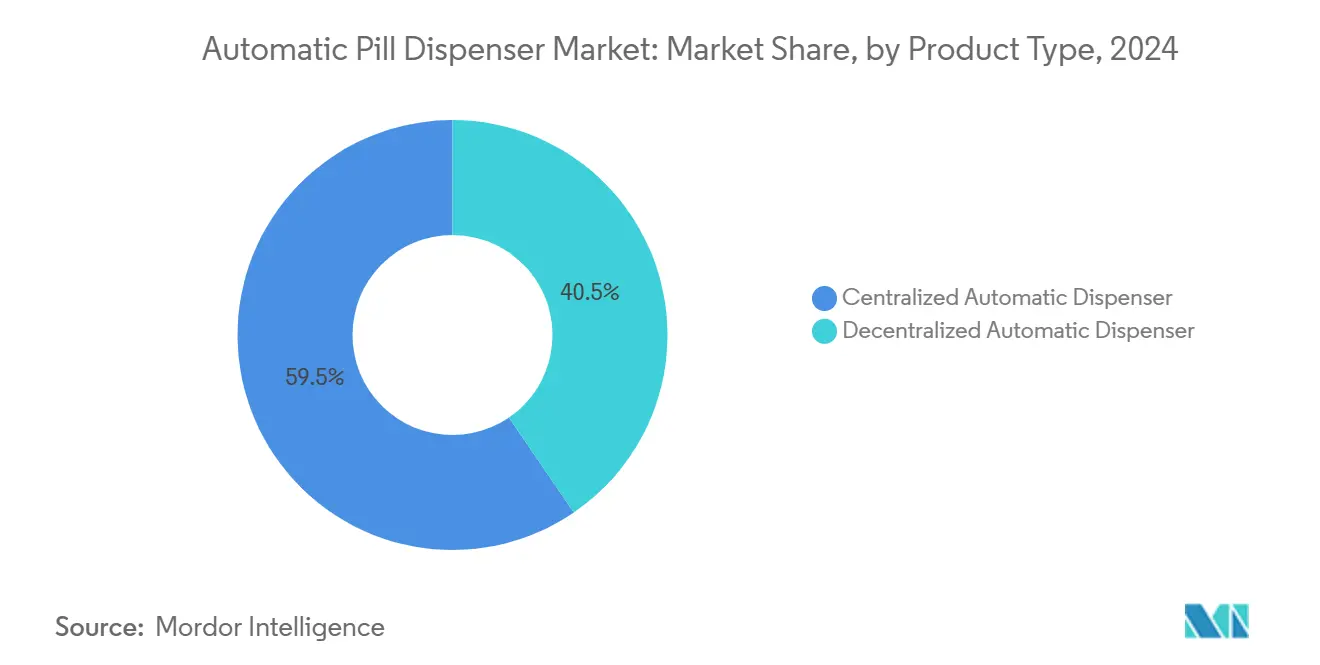
Note: Segment shares of all individual segments available upon report purchase
By Technology: Connectivity Redefines Medication Oversight
Programmable electronic dispensers accounted for 38.54% revenue in 2024, reflecting entrenched incumbency in hospitals that prize deterministic operation without network dependencies. Yet IoT-enabled units are forecast to lead growth at 12.61% CAGR, signaling a pivot in buyer priorities toward real-time data. These smart devices not only remind patients but also generate granular adherence trails, enabling predictive analytics that flag dose omissions before they escalate into clinical events. In a recent engineering study, the SPEC 2.0 prototype combined Wi-Fi, RF-ID, and cloud AI to prevent overdosing by comparing scheduled and actual retrievals.
This data-centric transformation is expanding the automatic pill dispenser market beyond hardware; subscription dashboards, API licensing, and remote therapy management services are emerging revenue lines. Manufacturers collaborate with telecom carriers to preload eSIM connectivity, guaranteeing global roaming without consumer setup. Cyber-hardened firmware updates, blockchain audit trails, and AI-driven refill forecasting further differentiate offerings. Programmable legacy units will persist in high-security wards where air-gapped architectures remain mandatory, but connectivity’s clinical value is positioning IoT devices as the default choice in outpatient and home-care arenas.
By Indication: Chronic-Disease Dominance and Cognitive-Care Upswing
Chronic disease management commanded 57.26% of 2024 revenue as polypharmacy regimens in diabetes, hypertension, and COPD necessitated strict dosing schedules. Improved adherence directly curtails emergency admissions, providing quantifiable ROI for providers and payers. In the Western Pacific alone, adult diabetes prevalence is set to climb from 215.4 million in 2024 to 253.8 million by 2050, underscoring sustained demand for regimen-support tools. Consequently, hospitals integrate dispenser data with telehealth check-ins, creating blended care pathways that seamlessly escalate alerts when blood-glucose logs deviate.
Neuro-degenerative disorders & dementia appear as the fastest-growing segment at a 10.29% CAGR, reflecting mounting societal focus on aging with dignity. Devices such as the MedaCube have already logged over 100 million dispensed doses, pairing tamper alarms with caregiver notifications to thwart missed or duplicate ingestion. Emerging models use facial-recognition cameras to ensure the correct patient retrieves the dose, addressing challenges in memory-care facilities. As cognitive-supportive design becomes mainstream, firmware designers infuse calm tones, color-coded lights, and simplified on-device buttons to reduce anxiety in users with sensory processing difficulties. The automatic pill dispenser market thus bifurcates into broad chronic-care platforms and specialized neuro-support offerings, each with tailored feature sets and pricing tiers.
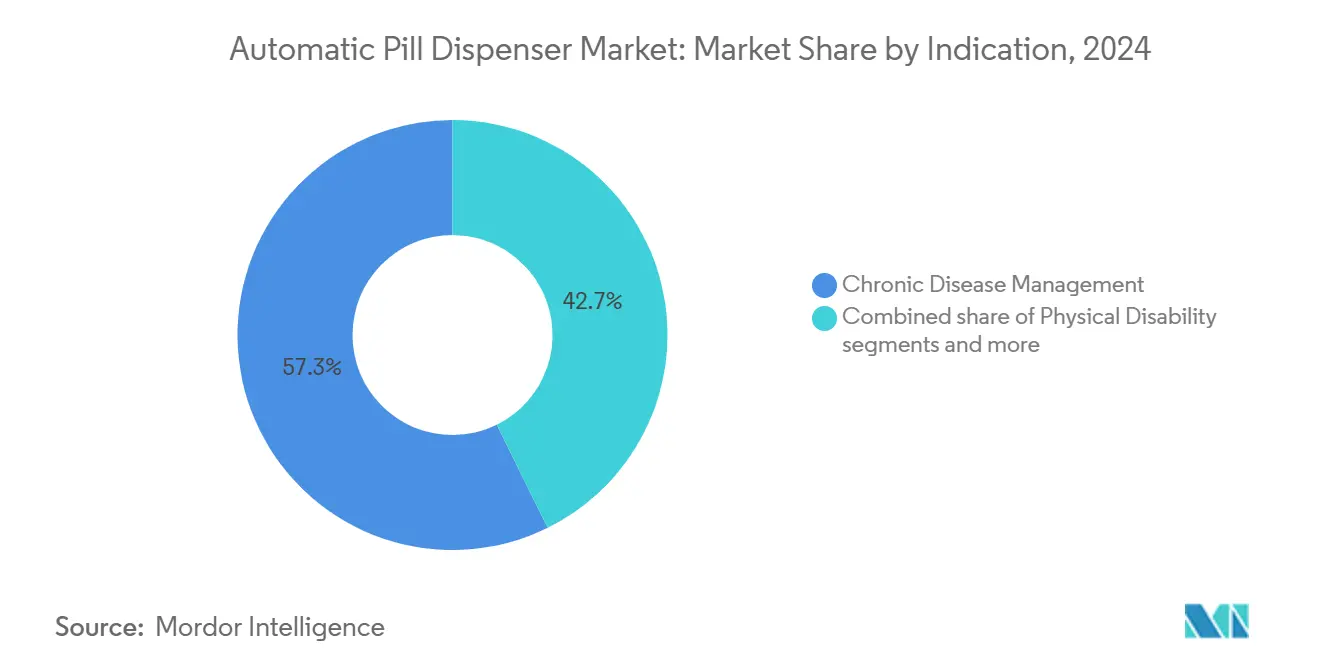
Note: Segment shares of all individual segments available upon report purchase
By End-User: Hospitals Still Lead but Homes Surge
Hospitals retained 46.32% revenue in 2024, leveraging enterprise robots to balance inventory precision with regulatory compliance. Comprehensive implementations span sterile-compounding interfaces, automated storage, and analytics dashboards that inform formulary decisions. Nevertheless, home-healthcare exhibits the highest velocity at an 11.78% CAGR. Payers encourage outpatient management to cut readmission penalties, and consumers prefer the autonomy of self-administration backed by virtual nurse oversight. As a result, connected devices designed for lay users integrate pre-filled cartridges shipped directly from partner pharmacies, reducing handling errors.
Long-term-care facilities function as a bridge market, adopting mid-scale cabinets that combine hospital-grade security with simplicity for caregivers operating across multiple rooms. Some vendors now offer roaming carts with built-in printers for on-the-spot labeling, ensuring compliance even during patient transfers. The segment’s growth reinforces a broader theme: technology stacks must flex across varied care settings without losing data lineage, pushing manufacturers to design modular hardware and interoperable software from day one.
Automatic Pill Dispenser Industry Geography Analysis
North America held 40.84% revenue in 2024 thanks to mature reimbursement pathways, early EHR adoption, and demographic tailwinds. U.S. Census Bureau projections show citizens aged 65+ climbing to 82 million by 2050, a trajectory that magnifies chronic-care workloads. Hospital systems respond by embedding centralized robots into medication-use workflows, while Medicare Advantage plans subsidize home-dispensing kits for high-risk members. State privacy laws mirror HIPAA but add patchwork nuances, prompting device makers to offer configurable compliance modules. Seed-stage start-ups cluster around Boston and Silicon Valley, leveraging abundant digital-health capital to prototype niche adherence analytics, further expanding the automatic pill dispenser market.
Asia-Pacific is the fastest-growing region with an 11.37% forecast CAGR. China invests heavily in pharmacy robots that automate sorting, packaging, and dispensing to cut wait times and errors. Provincial tenders now specify AI-powered inventory forecasting, pressuring global suppliers to localize algorithms for Mandarin drug databases. Japan’s persistent clinician shortfall drives adoption of point-of-care cabinets that liberate nurses from manual counting. India’s rising middle class expands the consumer base for connected devices, many of which leverage locally produced low-power chips to keep retail prices competitive. Government digital-health missions that reimburse tele-consults indirectly elevate demand for home dispensing, weaving the automatic pill dispenser market into the broader smart-health narrative.
Europe remains a sizeable contributor, anchored by strict CE-mark processes that favor vendors with strong quality-management pedigrees. Integrated care pathways in the UK and Nordic nations require dispensers to pass data through secure health-information exchanges, making interoperability a procurement criterion. Germany’s hospital modernization fund subsidizes pharmacy automation, accelerating replacement of manual trolleys with robotic arms. France’s social-insurance system covers connected devices for select chronic indications, spurring adoption among cardiology outpatients. Demand also rises for dementia-friendly hardware: UK manufacturer Pivotell designs easy-load carousels that community nurses deploy during domiciliary visits, underscoring Europe’s commitment to aging-in-place policies.
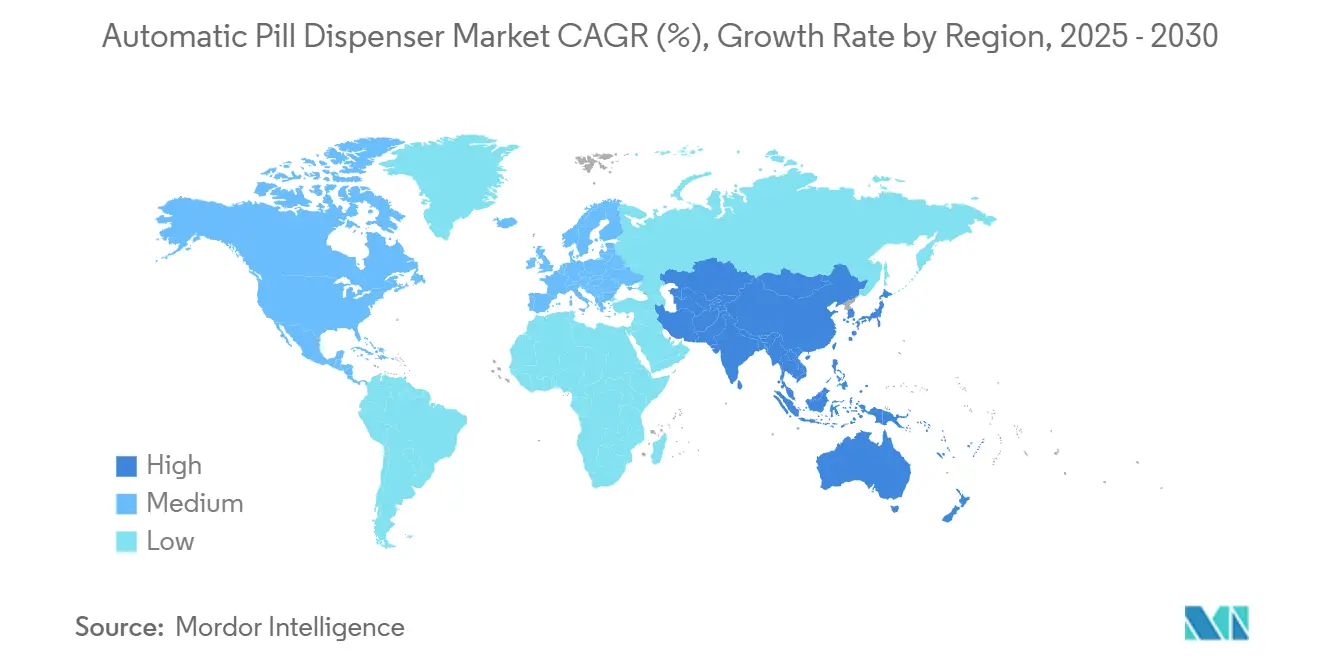
Competitive Landscape
The automatic pill dispenser market demonstrates moderate fragmentation, with scale advantages in institutional robotics counterbalanced by low entry barriers in consumer IoT devices. Omnicell and Becton Dickinson dominate hospital installations through end-to-end platforms that integrate storage, retrieval, and analytics. Start-ups such as Hero Health and PharmAdva target home-care niches, bundling subscription refills and caregiver dashboards to build recurring revenue.
Strategic alliances are proliferating. Swisslog Healthcare collaborates with pneumatic-tube suppliers to interconnect ward cabinets and central pharmacies, reducing transport lag for STAT doses. Meanwhile, Asian OEMs leverage domestic manufacturing scale to undercut western price points, prompting incumbents to roll out mid-tier offerings for cost-sensitive buyers.
Innovation cycles revolve around data services. Vendors release AI modules that predict missed doses, recommend titration timing, or flag potential interactions, transforming devices into clinical-decision supports. Some players nurture open-API ecosystems, inviting third-party developers to build add-ons such as language-localized voice prompts. This API strategy embeds hardware inside larger digital-health stacks, heightening switching costs. M&A chatter centers on analytics firms able to ingest dispenser telemetry, indicating that future consolidation may pivot more on data science than on mechanical engineering.
Automatic Pill Dispenser Industry Leaders
-
Omnicell Inc.
-
Swisslog Healthcare
-
Capsa Healthcare
-
Becton Dickinson & Company
-
Hero Health Inc.
- *Disclaimer: Major Players sorted in no particular order
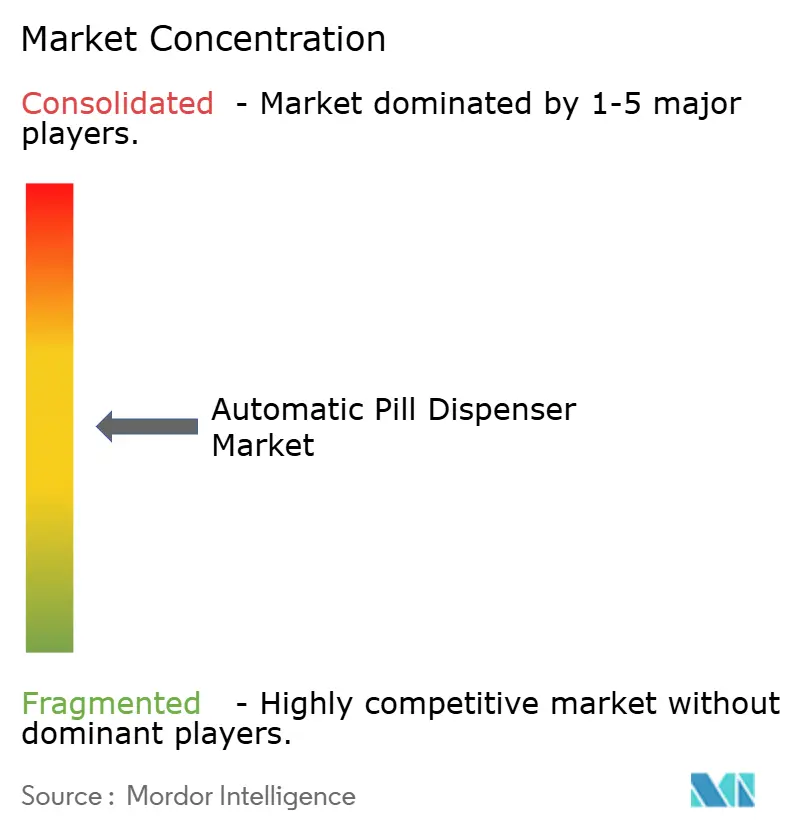
Recent Industry Developments
- March 2025: India’s MIT World Peace University unveiled an IoT-enabled modular tablet and capsule dispenser for remote medication monitoring.
- October 2024: The National Heart Institute, Malaysia, installed i-Pharmabot, the country’s first automated dispensing medication system.
- February 2024: Pusan National University Yangsan Hospital became the first Korean site to deploy the Fixu G2 automated cabinet.
- February 2023: Rajiv Gandhi Government General Hospital, India, installed an automated device to deliver drugs for non-communicable disease patients.
Research Methodology Framework and Report Scope
Market Definitions and Key Coverage
Our study defines the automatic pill dispenser market as all electronically controlled devices that store, schedule, and release solid-dose medications without manual counting, spanning centralized carousel or robotic benches installed in pharmacies and smaller IoT linked units used at ward level or in home care settings. The valuation tracks new equipment sales and associated embedded software revenues in US dollar terms.
Scope exclusion: after-sales consumables, service contracts, and stand-alone smart pill bottles that lack programmable dispensing are not counted.
Segmentation Overview
- By Product Type
- Centralized Automatic Dispenser
- Carousels
- Robotic
- Decentralized Automatic Dispenser
- Ward-Based Automated Dispensing System
- Pharmacy-Based Automated Dispensing System
- Automatic Unit-Dose Dispensing System
- Centralized Automatic Dispenser
- By Technology
- Mechanical Timer-Based
- Programmable Electronic
- IoT-Connected (Bluetooth / Wi-Fi / Cellular)
- Other Technologies
- By Indication
- Physical Disability
- Neuro-degenerative Disorders and Dementia
- Chronic Disease Management
- Other Indications
- By End-User
- Hospitals
- Pharmacies and Pharmacy Benefit Managers
- Home Healthcare
- Long-Term Care Facilities and Nursing Homes
- By Geography
- North America
- United States
- Canada
- Mexico
- Europe
- Germany
- United Kingdom
- France
- Italy
- Spain
- Rest of Europe
- Asia-Pacific
- China
- Japan
- India
- Australia
- South Korea
- Rest of Asia-Pacific
- Middle East and Africa
- GCC
- South Africa
- Rest of Middle East and Africa
- South America
- Brazil
- Argentina
- Rest of South America
- North America
Detailed Research Methodology and Data Validation
Primary Research
Mordor analysts spoke with pharmacy directors, biomedical engineers, long-term care administrators, and home care device distributors across North America, Europe, and Asia Pacific. Interviews validated average shift level transaction counts, adoption barriers, and price dispersion, while short surveys with geriatric caregivers refined home use penetration rates.
Desk Research
We gathered baseline volumes and prices from public datasets such as US FDA device registrations, Medicare hospital cost reports, EU Eudamed listings, and Japan's PMDA import filings. We then supplemented them with usage data from trade groups like the American Society of Health-System Pharmacists and the International Pharmaceutical Federation. Company 10-Ks, investor decks, and reputable media articles offered shipment disclosures and ASP hints, which were cross-checked inside D&B Hoovers and Dow Jones Factiva. Additional unit flow clarity came from customs codes HS 847989 and HS 902110 available via Volza. This list is illustrative; many other open sources informed data cleaning and gap fills.
Market-Sizing & Forecasting
A top down model starts with installed pharmacy outlets and hospital beds by country, applies dispenser penetration ratios, and multiplies by weighted average selling prices. Selective bottom up checks roll up shipments disclosed by key manufacturers to keep totals grounded. Variables that move the base include: 1) new prescription volume per capita, 2) geriatric population growth, 3) chronic disease prevalence, 4) average dispenser replacement cycle, and 5) capital budget allocation trends. Multivariate regression links these drivers to historical sales, while an ARIMA overlay captures short run shocks such as pandemic era tele-pharmacy surges. Gaps in supplier data are bridged with region specific ASP imputation before results are re-benchmarked.
Data Validation & Update Cycle
Outputs face three stage peer review, variance checks versus external device shipment tallies, and anomaly flags that trigger re-contact with sources. Reports refresh yearly, with mid-cycle tweaks for material recalls or regulatory shifts; a final analyst pass guarantees clients receive the latest vetted view.
Why Our Automatic Pill Dispenser Baseline Commands Reliability
Published estimates often differ because firms pick unique device lists, pricing ladders, and refresh cadences.
Key gap drivers we observe are divergent inclusion of smart pill boxes, varying assumptions on hospital versus home mix, currency conversion dates, and whether refurbished units are counted.
Benchmark comparison
| Market Size | Anonymized source | Primary gap driver |
|---|---|---|
| 3.64 B (2025) | Mordor Intelligence | - |
| 3.10 B (2024) | Regional Consultancy A | Excludes home care IoT units, uses 2021 ASPs |
| 2.90 B (2024) | Trade Journal B | Counts only centralized pharmacy systems, omits Asia Pacific sales |
In summary, by aligning scope with real world purchasing channels, using live ASP checks, and refreshing every twelve months, Mordor delivers a balanced, transparent baseline that decision makers can trace back to clear variables and repeatable steps.
Key Questions Answered in the Report
What is the primary factor influencing hospitals to adopt centralized automatic pill dispensers?
Hospitals emphasize these systems because they dramatically cut medication‐preparation errors and free pharmacists for higher-value clinical tasks, aligning with quality-of-care metrics linked to reimbursement.
How are data-privacy regulations shaping product design for connected pill dispensers?
Manufacturers now build in end-to-end encryption and secure authentication from the outset, as compliance with HIPAA, GDPR, and similar laws has become a critical purchase criterion for healthcare providers.
Why are insurers increasingly willing to reimburse home-use automatic pill dispensers?
Payers view these devices as preventive tools that lower avoidable hospitalizations by improving adherence, making the upfront hardware cost attractive compared with potential acute-care expenditures.
In what way are workforce shortages influencing dispenser adoption in Asia-Pacific hospitals?
Facilities facing nurse and pharmacist gaps use automation to maintain service levels, with dispensers taking over repetitive dispensing tasks so limited staff can concentrate on direct patient care.
How are technology partnerships affecting competitive positioning among dispenser vendors?
Alliances with cybersecurity, telehealth, and analytics firms enable vendors to offer integrated ecosystems rather than stand-alone devices, creating differentiation that resonates with digitally mature health systems.
Page last updated on:



